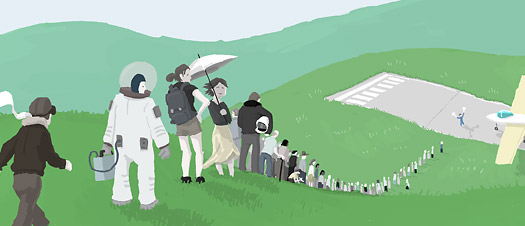The previous State of Sync posts were fairly technical, at least when compared to other posts that have appeared here in the past. This time, however, I will concentrate on user-level aspects – and I’ll give a timeframe for our next steps.

After the previous post, our tech support team received quite a few inquiries about what exactly our forthcoming cloud sync solution would entail for end users. To help answer these questions – at least those we could answer at that time – we published this FAQ page. Today I'd like to answer some more of your questions – extending and updating that with some new information.
How it will work
As the name already implies, our sync solution is provided as a service that lives in the cloud. This means that the creation of an online account will be a user’s first necessary step in the configuration of Things for sync.
Of course, Things on the Mac and iOS devices will also need to be updated, in order to enable communication with the cloud server. This software upgrade will come at no charge, and will also sport a revamped database layer that is not only faster, but specifically optimized for cloud sync usage.
Things will sync frequently. While there will be a way to initiate sync manually there should hardly be any reason for doing so. Every change you make is transmitted to the cloud almost instantly. No matter when you quit the app, your data is safe with the server already. Whenever you open Things, switch applications, or wake your computer from sleep, Things will check back with the server to see if there are any updates to pull.
Things will always connect to the server using an encrypted connection. Not only during log-in, as many web sites do, but for every connection. This means that your to-dos will never be sent in the clear.
Service costs
Without large scale tests, it is not realistic to estimate how much resources our users will consume in the cloud. In particular, the frequency of interactions between users’ databases and the central service. Therefore we will be doing extensive scalability testing before we make an announcement regarding possible costs for the service.
Bonjour sync
Some users were asking about the future of our existing Bonjour-based WiFi sync. As a matter of fact, our Bonjour sync – in its current form – is incompatible with the database layer improvements I mentioned above. As a consequence, there is no way for us to keep the old sync approach with the improved database layer. What we are planning to do instead, is to rebuild WiFi sync using the same core components that also power our cloud sync technology. We’ll achieve this by putting a little sync server into Things Mac. This is something that might not ship with the initial release of cloud sync, but shortly thereafter.
Things Mac cloud sync beta
I’m sure the question on the mind of many readers is: when will I be able to play with Things cloud sync first-hand? As it happens, the integration of cloud sync with the Mac version is a little further ahead of its counterparts on iOS. We have therefore decided to start with a beta of Mac-to-Mac sync first.
Initially, the cloud sync beta will be invite only. Everybody can subscribe, but we will activate accounts on a first come, first served basis as we gradually scale up the beta. We will be starting with a small number of beta testers at first – the idea is to iron out any kinks on the server early on – we will then slowly add more people in order to test our system under increasing load. iOS devices will join the fun once we are confident with everything server-side.
When will this happen? We are expecting to start sending out invitation emails on May 2.
But there is one more thing…
The subscription page is already live. If you want to become a test pilot for Mac-to-Mac sync, please sign up here.
We will publish our next sync-related blog post once the beta is ready.